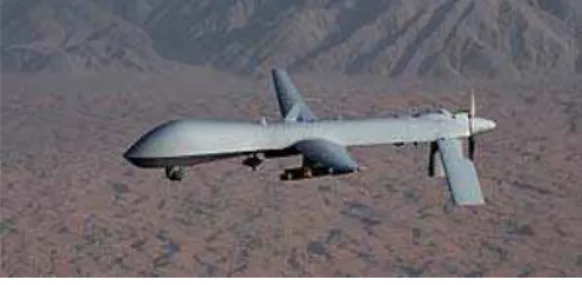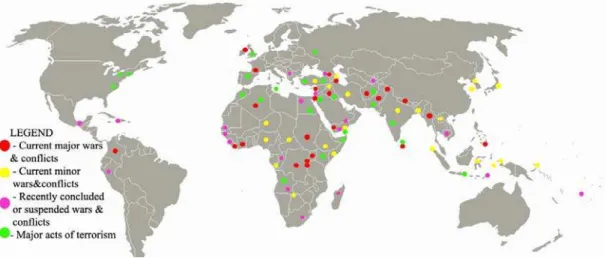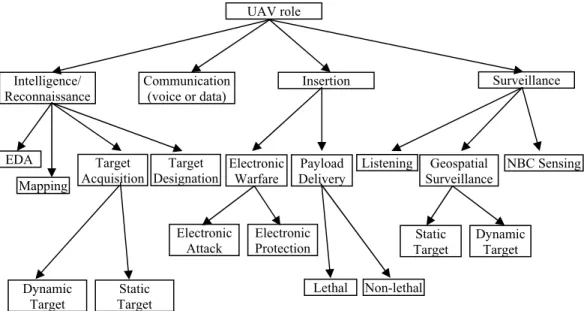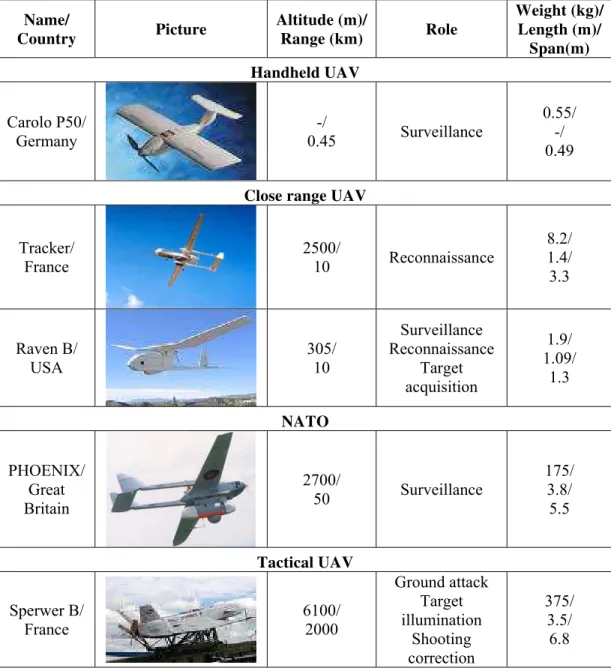theaters of operations
Niculae MARIN
*, P
ǎ
tru SP
Ă
TARU
***
Aerospace Consulting
Bdul Iuliu Maniu 220, Bucharest 061136, Romania
marin@incas.ro
**
INCAS - National Institute for Aerospace Research “Elie Carafoli”
Bdul Iuliu Maniu 220, Bucharest 061136, Romania
pspataru@incas.ro
Abstract: Current theaters of operations are not limited to battlefields, but they are much more diversified, including the fight against the international terrorism phenomenon, the social conflicts (of religious, political, economic and separatist nature) within several countries, thus supplying some political-military conflicts within different states and areas of the world. The armed interference must be done based on some highly accurate information that must be gathered without endangering the human lives. This is the role currently played by the unmanned air vehicles (UAVs); they can perform several functions: surveillance, information gathering, data storage and their transmission to the ground stations, including the function of interference, when needed. This paper presents, within the above context, the status of the current theaters of operations and of the UAVs performing different missions within these theaters, together with their role and importance in warfare operations.
Key Words: UAV, theater of operations, conflict zone, intelligence, surveillance, reconnaissance
1. INTRODUCTION
The unmanned air vehicles (UAV) have reached an unprecedented level of development and distribution so that in the next two decades they will probably take the lead on the battlefield. From a strategic point of view, since 1997 USA have issued a long term development plan, which they have subsequently upgraded, thus we can now speak about a UAVs hierarchy depending on their destination, action area, intervention means within the battlefield and their conventional operating echelon.
If in the first Gulf war a single UAV had been used, eight years later their number increased to three vehicles used by the allied forces in Iraq, especially for aerial research and surveillance [7]. Initially, in Afghanistan there have also been used three UAVs, the essential difference being that the first RQ-1 Predator (Fig.1) had been used there for combat, data gathering and surveillance missions.
Fig. 1 – RQ-1 Predator Unmanned Air Vehicle
The analysis undertaken by the U.S. Army showed that in 2006, 46% of the UAV-related capacity requirements were not accomplished, especially with respect to the location of the ground targets and the precision attacks directed on them.
The purpose of this paper is to review the unmanned air vehicles, the status of the technological development in the field (especially in the European Union member states) and to highlight the role and importance of UAVs within the current theaters of operations, as well as the capabilities this type of airplane may have, through the comparison between the strategic mission and the current technological level.
2. THE CONFLICT AND WAR ZONES STATUS AND /THEIR/
DISTRIBUTION AREA
We can talk about [1], [2], [3]:
a) “major” current wars and conflicts, defined as those where the victims number overcomes a few thousands of people involving at least one nation (internal wars or conflicts), or at least two nations (international conflicts), and/or generating a multi-national regional conflict.
b) “minor” wars and conflicts, which have a relatively low impact on the world or the region where they take place. Generally speaking, these conflicts may cause at most 1000 victims, involving one (internal conflict) or at least two nations (international conflict), and they do not generate multinational regional conflicts.
c) recently ceased or suspended wars and conflicts – those where the fire have been ceased, a peace treaty was signed or hostilities have ceased permanently. Many of these conflicts may easily be resumed. Mainly these conflicts remain at this level for at least ten years.
d) major acts of terrorism – a category that is still not completed, but that develops in the form of major acts of terrorism across all continents. These attacks are staged either by some countries, or by terrorist organizations.
In the first category we have: the Afghanistan war, the Israeli-Palestinian conflict, which may degenerate into an international conflict; the Algerian civil war, started in 1992 and still developing; the Basque separatist conflict , started in 1958 and still active; the civil war in Burma (Myanmar), started in 1948; the civil war in Burundi, started in the year 1994;
the Colombian civil war, started in the year 1964; the second Congolese war (considered to be a regional war), started in 1998, when the Congolese rebels, backed by Rwanda, Uganda and Burundi, attempted to overthrow the president, which was supported by the rebels in the above three countries, together with the armies of Angola, Zimbabwe and Namibia. The estimated number of dead in this war is over 1 million people, mostly civilians. We may continue with the second war in Chechnya, the war in the Gaza Strip, the war in the no fly zone (the Iraq coalition conflict), the Israeli attacks on the Syrian forces in Lebanon (high risk of developing into a regional war), the civil war in Cote d’Ivoire, the Kashmir conflict (high risk of regional war), the Liberian civil war, the civil war in Nepal (1996-present), the conflict in the Northern Lebanon (2007), the conflict in the Northern Ireland (1969 – present), the conflicts in Philippines (the Moslem rebellion (1969-present) and the rebellion of the new popular army (1969 – present)), the civil war in Rwanda (1994-present), the civil war in Sri-Lanka (1983 – present), the civil war in Sudan (1983 – present) and others, shown on the map of the world in Fig. 2.
Within the category of “minor” current conflicts and wars, we mention: the independence war in Bougainvillea started in 1989 and currently developing, the separatist war in Cabinda (Angola), started in 1984 and ongoing, the border conflict between Chad and the South-African Republic, started in 2002, the Hmong insurrection in Laos started in the year 1975 and ongoing, the minor wars in India (Naga rebellion, Mizo rebellion, Naxalite guerilla warfare, Tripura, Assam, Bodo rebellions), the minor wars within the Indonesian zone (West Papua rebellion, Aceh rebellion, the ethnic violence in Ambon, the sectarian violence in Sulawesi) and many others that are also represented on the map of the world in Fig. 2.
Among the wars or conflicts in the c) category, we may include: the civil war in Angola (1975-2002), the civil war in Cambodgia, the civil war in Congo-Brazaville (1997-2000), the civil war in Fiji, the Kosovo war (1998-1999), the Israeli occupation of the South Lebanon (1998-2000). The wars and conflicts represented on the world map in Fig. 2 could be added to the above.
Within the d) category of the major acts of terrorism, we may include: the terrorist attack against the United States in 2001, the attack on the Israeli tourists from Kenya (November 28th, 2002), the bomb attack in Bali (October 12th, 2002), the bomb attack on a synagogue in Tunisia (April 11th, 2002), the terrorist attack in the capital of Spain of March 11th, 2004, when 121 persons were killed, the terrorist attacks from the London public transportation, one on July 7th, 2005, when 56 persons were killed, out of which 4 terrorists, and the second on July 21st, 2005. All the above attacks were planned and executed by the terrorist organization Al-Qaeda. More recently, we may speak about the terrorist attacks on two subway stations in Moscow (March 29th, 2010).
In conclusion, in the first decade of the XXIth century, 23 “major” conflicts, 79 “minor” conflicts and 175 conflicts that may be included in the violent political category, took place and are still developing.
This presentation aims to highlight the utility of UAVs in preventing and
combating civil and military conflict whose victims are innocent people.
3. THE ROLE OF UAV WITHIN THE THEATERS OF OPERATIONS
- surveillance representing a monitoring process of the humans’, objects’ or processes’ behavior, to be compared to the expected or required norms (for example, detecting some nuclear, biological or chemical activities or phenomena);
- intelligence considered to be a military branch of knowledge, which concentrates upon the gathering, analysis, protection and dissemination of the information about the enemy, field and weather in the military operations area or within the area of interest;
- reconnaissance having the purpose of inspecting or scanning an area to gather information;
- communications, in which case they can perform units connecting missions, including the connection to the higher command structures;
- insertion for the load delivery within specific target areas. For military purposes, we can talk about weapons airdropping (not necessarily lethal) and that could also include electronic war actions and target destruction actions. The electronic war actions may have two features: the attack against the enemy, for the electromagnetic jamming or by high energy weapons bombing of the convoys, and the protection of their own and allied communications, equipments or objectives;
- target represented by a UAV that can be used to simulate a fighter aircraft or a missile in the following purposes:
operators’ training, in this case being considered as a practice target;
imitation of any kind of a person, object, phenomenon to mislead the enemy surveillance devices or the enemy report, in this case the UAV being used as bait. Figure 3 presents, in a simplified diagram, the roles of the UAVs used in the armed conflicts, regardless their nature, as they have been defined in the previous sub-chapter.
A UAV could certainly perform one or more of the above mentioned roles [5].
UAV role
Intelligence/ Reconnaissance
Insertion Communication
(voice or data)
Target Acquisition
Surveillance
Mapping
EDA Target
Designation
Dynamic Target
Static Target
Electronic Warfare
Payload Delivery
Electronic Attack
Electronic Protection
Lethal Non-lethal
Listening Geospatial Surveillance
NBC Sensing
Static Target
Dynamic Target
Fig. 3 – UAVs role in the armed conflicts
UAVs could be classified depending on the action range /altitude and as agreed upon within some industry events, in [4]:
- NATO – 3000 m altitude and the action range of about 50 km; - tactical (TUAV) – 5500 m altitude and action range of about 160 km;
- MALE (Medium Altitude, Long Endurance) – up to 9000 m altitude and action range of about 200 km;
- HALE (High Altitude, Long Endurance) – above 9000 m altitude and unlimited action range;
- HYPERSONIC – high speed, supersonic (1 – 5 Mach) or hypersonic (above 5 Mach), flight altitude of more than 15200 m or sub-orbital altitude, having the action range of more than 200 km.
In Table 1 there are a few examples of currently used UAVs, to fit on the above classification and their main features [8].
Table 1 – Currently UAVs used in conflict zones
Name/
Country Picture
Altitude (m)/
Range (km) Role
Weight (kg)/ Length (m)/
Span(m) Handheld UAV
Carolo P50/ Germany
-/
0.45 Surveillance
0.55/ -/ 0.49
Close range UAV
Tracker/ France
2500/
10 Reconnaissance
8.2/ 1.4/ 3.3
Raven B/ USA
305/ 10
Surveillance Reconnaissance
Target acquisition
1.9/ 1.09/
1.3
NATO
PHOENIX/ Great Britain
2700/
50 Surveillance
175/ 3.8/
5.5
Tactical UAV
Sperwer B/ France
6100/ 2000
Ground attack Target illumination
Shooting correction
375/ 3.5/
Shadow 600/ USA 4877/ 200 265/ 4.88/ 6.7
Medium altitude, high endurance (MALE)
Predator A/ USA 7620/ 3704 Ground attack Reconnaissance and surveillance Target scanning, accompanying and acquisition 1020/ 8.22/ 14.8 HERON TP/ Israel 10000/ 350 Target acquisition Shooting correction Intelligence Surveillance 1150/ 8.5/ 10.6
High altitude, high endurance (HALE)
EuroHawk/ EADS 19800/ 22236 Ground attack Reconnaissance and providing the connection between the military commanders and the real battlefield on a
Hypersonic
X-43A/ USA
www.aaa.com
30480/ 2235 m/s
(6.57 Mach)
-/ 3.66/
-
All UAV-s in Table 1, except for EuroHawk and the hypersonic UAV, which is still in the development stage, have participated to actions within the war theaters in Afghanistan, Iraq, and Kosovo and to peacekeeping operations in some of the conflicts mentioned in paragraph 2.
The UAV role has become a very important one. Only in 2005, on the tactical level, UAVs have performed over 100.000 flight hours in peacekeeping missions and operations in Iraq. Using UAV-s in combat is no longer a formality, as they perform, together with the intelligence, surveillance and reconnaissance missions, electronic attack, missions of impact, neutralization and/or destruction of the enemy anti-aircraft means, communication and traffic junctions and networks, aerial research and even rescue missions, with all their versions. These UAV-s cost from several thousand to tens of millions of dollars, and their weight is between several hundred grams and about 15.000 kg.
4. TECHNOLOGICAL DEVELOPMENTS AND THEIR EFFECT ON THE
BATTLEFIELD
The purpose of the technological developments is that UAV-s become almost completely autonomous and independent from the ground-made decisions.
The system must replace the pilot in what concerns the maneuvering, memory, logics, adjustment to new situations capabilities and his capacity to use the lessons learned during the previous missions.
This especially requires the development of the CPUs size and capacity, together with the communication capacity and their connections for data transfer [10].
The improvement of the high range sensors, which would allow the UAV-s to reach removed targets and would provide the capacity to keep their position in a certain sector proves to be necessary. The improvement of the engines, aerodynamics and refueling during the flight is therefore necessary [8].
Less important, but a major challenge for the industry, are the need and capacity to reload the onboard weapons systems with ammunition.
Here are some practical examples that will form the basis for further technological development [9]:
- between 2010-2015, there will be algorithms and processors allowing the automatic recognition of a wide range of military vehicles;
- within 2025-2030 it is expected that the speed and memory of these processors to be equal to those of a human and the computers to be small enough to be used on a military UAV;
At large, these technological improvements mean that:
- during 2010-2015, they will be able to participate to ground attack missions on the enemy territory;
- during 2025-2030, they will be able to participate to more complex missions, like the aerial transport and the missions that will simultaneously incorporate ground attacks and anti-aircraft operations.
This trend is already reflected by the decrease of the electronic parts, which offers the capacity to switch from a large platform to a smaller one.
As a consequence, in the next twenty years, UAV-s will begin to replace the fighter aircrafts.
This will obviously affect the battlefield, both for the users and for the future enemies. The first positive aspect on the battlefield will be the reduction, or even the extinction of the current limitations of the airborne weapons. This includes the observation over a given sector, the reliability of the airbases, the high cost of the specialized aircrafts and the sensitivity to extreme meteorological conditions.
In the case of observation over a given sector, the commander’s role is greatly simplified, as he doesn’t have to worry about the rest of the crew, the time spent on alert on the ground or in-flight by a combat air patrol, waiting for an enemy which might never show up.
Finally, according to Moore’s law, the increased costs of the specialized fighter aircrafts, both for their purchasing and for their operation, shall be decreased by lowering the cost of each and every UAV.
This shall affect the operational supply chain. There will be fewer sorties to plan to obtain the same effect, which will affect the ground support, as well as the optimization of the time required for maintenance. There will also be smaller quantities of material, especially fuel, to handle.
The air coordination and control shall benefit with respect to a reduced demand of the program, the routes, avoiding the forbidden sectors, the flight levels estimation, etc.
Because of their computers, the UAVs shall follow some accurately programmed or re-programmed instructions, which will lead to a better performance.
Finally, regarding the human resources, not only the flight crews will be exempted from the major operational commitments, but also the whole combat system. Each UAV needs fewer personnel for its operation and support.
The result is that, purely quantitatively speaking, the number of targets for the enemy to hit is greatly reduced. There will be neither a large concentration of fuel, nor big shelters, nor landing tracks. It will not be easy for the enemy to find the gravity center that he should aim for, because the targets will be dispersed all over the battlefield.
5. CONCLUSIONS
1. UAV-s could replace the piloted fighter aircrafts in every operational mission, from reconnaissance and combat to refueling and transport. Their importance will increase together with the technological developments to be accomplished in the next 20 years [12].
3. The use of highly sophisticated and accurate systems in combat missions will
bring a series of advantages to the air commander who leads them, especially if he
must face an enemy who has the same systems.
REFERENCES
[1] Cornel Cucu, Operaţiile de menţinere a p cii – actualitate şi tendinţe, Revista “Colocviu strategic” Nr. 11 (XX), Ianuarie 2006;
[2] Shah Anup, Conflicts in Africa, http://www.globalissues.org/issue/83, 2009; [3] The History Guy, New and Recent Conflicts of the World,
http://www.historyguy.com/current_conflicts/index.html;
[4] European Commission Enterprise and Industry Directorate-General, Study Analyzing the Current activities in the Field of UAV, ENTR 2007/065;
[5] Nehme C. E., Cummings M.I., Crandall J. W., A Uav Mission Hierarchy, Massachusetts Institute Of Technology, HAL2006-09, 2006;
[6] van Blyenburgh Peter, Unmanned Aircraft Systems - The Current Situation UAS, UAS ATM Integration Workshop EUROCONTROL Brussels, Belgium May 8, 2008;
[7] Fulghum A. D., Sweetman Bill, Black UAV Performs In Afghanistan, Aviation Week.com, 2009; [8] Military factory, http://www.militaryfactory.com/aircraft/, 2010;
[9] Mockenhaupt Brian, We've Seen the Future, and It's Unmanned, Esquire, 2009;
[10] Odom Earl “Duke”, Future missions for unmanned aerial vehicles: exploring outside the box - PIREP - military/air force equipment, Aerospace Power Journal, 2002;
[11] Story Anne, Gottlieb Aryea, Beyond the Range of Military Operations, Military Operations, JFQ, 1995; [12] Rocha Daniel R., Will Unmanned Aerial Vehicles (UAVs) replace manned aircraft?, GlobalSecurity.org,



